The Acer Swift 3 SF315-41 Review: Ryzen Meets Laptop
by Brett Howse on May 3, 2018 8:00 AM EST- Posted in
- Laptops
- Acer
- AMD
- Ryzen
- Ryzen Mobile
- Raven Ridge
GPU Performance: Vega at 15-Watts
We’ve been stuck in a bit of a rut with laptops lately. Intel has been offering solid CPU performance for the past several years, but their integrated graphics solution, while excellent for media playback and desktop usage, struggles under any sort of 3D load. Enter the Vega GPU in Ryzen.
Vega, if you follow GPUs, is the current generation GPU that AMD offers for the desktop, but they’ve also modularized it to be able to pack it into a 15-Watt SoC. The Ryzen 5 2500U and Ryzen 7 2700U are pretty similar on the CPU side, with only 200 MHz of frequency separating them, but on the GPU side, AMD offers 8 Radeon Vega CUs in the 2500U, and 10 Vega CUs in the 2700U. As well, the higher-level model offers a higher maximum boost frequency of 1300 MHz on the 2700U versus 1100 MHz on the 2500U.
This is full Vega as well. For a deep dive, check out the Vega launch article, but this U series SoC offers the same features as its bigger desktop cousins, such as Rapid Packed Math, the improved geometry engine, and of course, the media blocks, such as 10-bit HEVC hardware offload, and VP9 hardware as well.
The Acer Swift 3 was run through our standard laptop GPU suite, and unlike the Intel 15-Watt parts, we ran it through the full suite. We’re in the midst of introducing a 2018 laptop GPU suite, but like the CPU tests, it’s important to have more data even if the games are older.
Looking at our comparisons, we’ve got a wide range. The Surface Book 2 offers a very powerful NVIDIA GTX 1060 GPU, in the same 15-inch size as the Acer Swift 3. The Surface Pro tablet is one of the few models we’ve seen with Intel’s Iris GPU, offering double the execution units over the normal HD620 or UHD620 found in the ASUS ZenBook 3.
3DMark
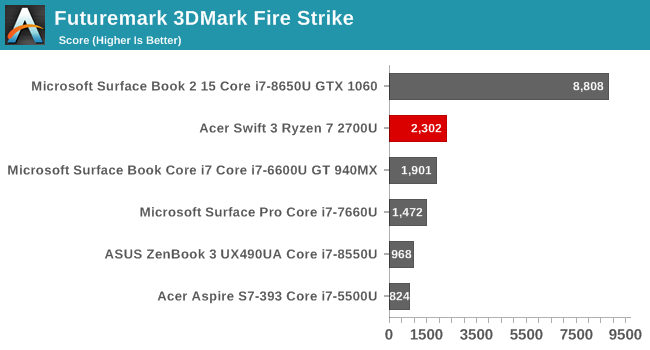
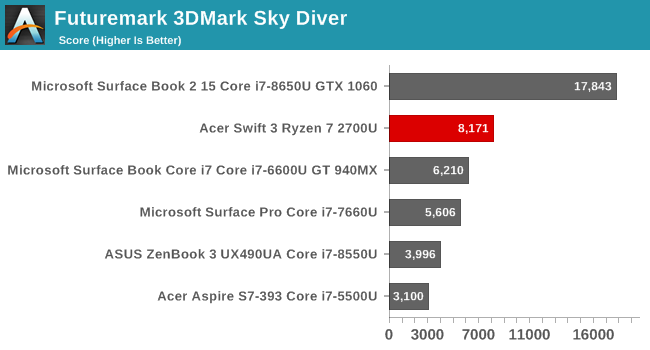
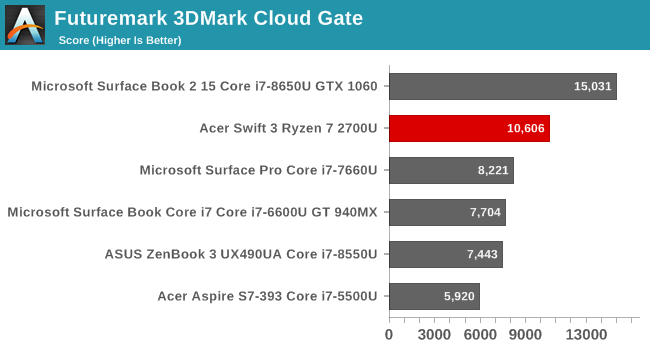

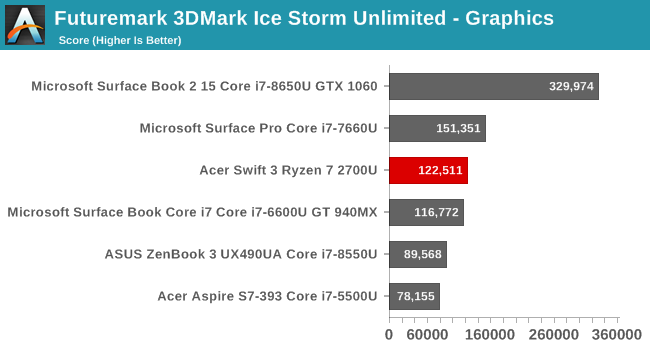
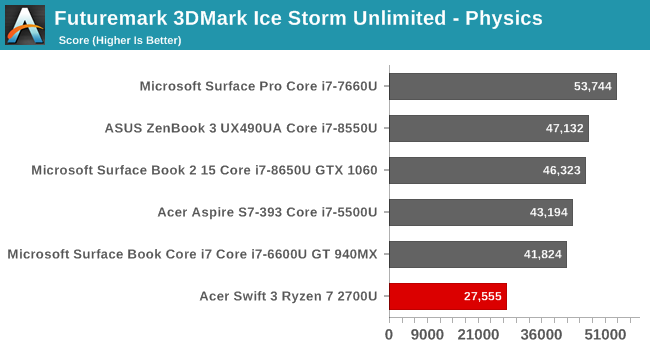
There’s a lot of interesting data to look at here. 3DMark offers several tests of increasing complexity, with the order of most demanding to least demanding being how they are presented above, with Fire Strike being the most demanding, and Ice Storm Unlimited the least.
Ryzen mops the floor with Intel’s GPU in any specification, including the Iris model. On Fire Strike, the CPU is the smaller factor, and the GPU runs away with it. As the tests get less demanding, they become more CPU bound though, and the less performant Zen cores bring down the overall results. That’s most obvious in the Ice Storm test, where we record the individual scores for GPU and CPU as well. The Physics result is a CPU bound test, and Intel’s ILP is clearly stronger.
GFXBench
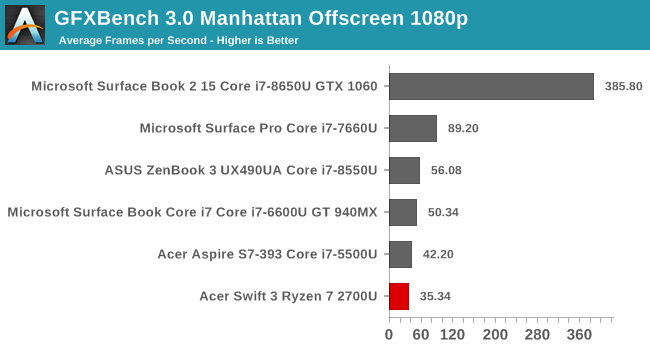
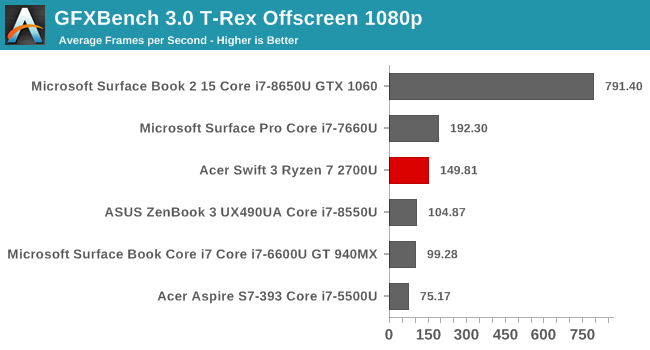
Although a benchmark geared towards smartphones and tablets, it’s always interesting to see how low-power laptops perform, even if the results are not 1:1 comparable. Here we seem to run into an issue with AMD’s OpenGL drivers, which are well behind in the Manhattan test compared to the Intel iGPU. Luckily for AMD, OpenGL isn’t a big focus right now, so despite the poor result, it’s not going to impact very many people.
Dota 2
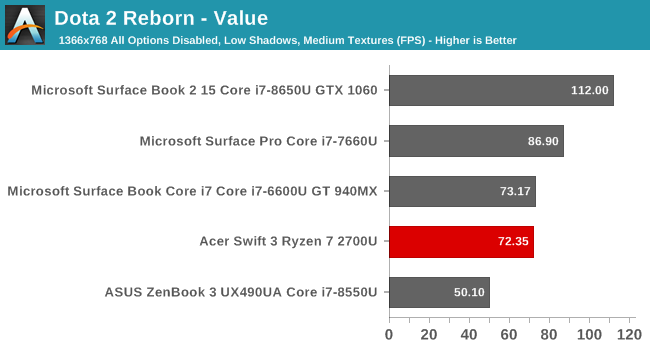
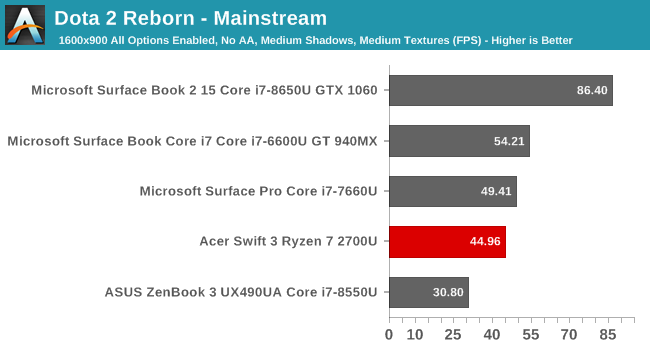
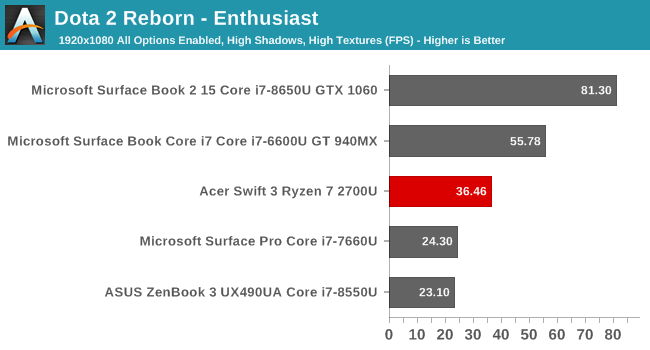
On most 15-Watt laptops, this is the only gaming benchmark we even test, because it’s one of the few that’s at least playable on low-end hardware. It’s actually CPU bound with even modest GPUs, but we can see the Ryzen 7 2700U easily surpasses the Core i7-8550U at all levels. The Surface Pro though with Intel Iris is able to stay ahead until the 1080p level thanks to the CPU performance and larger Iris GPU.
Tomb Raider
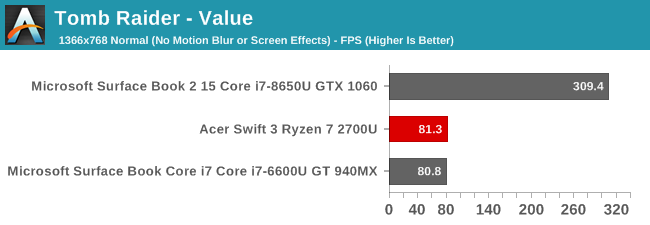
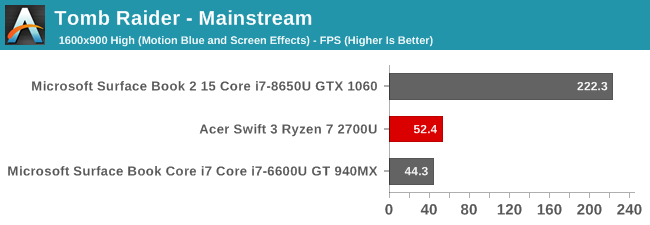
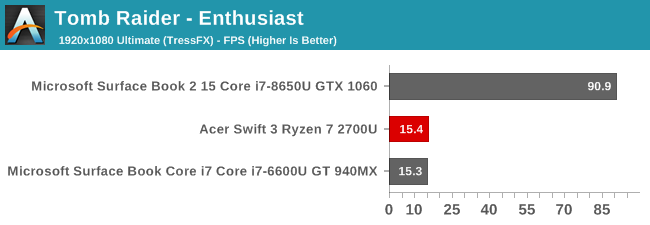
Although several years old now, the original Tomb Raider reboot is still a great looking game, and at maximum settings can be punishing to laptop GPUs. But it’s important to note that the Ryzen 7 is easily playable at low to medium settings.
Rise of the Tomb Raider

Newer, and even more demanding, Rise of the Tomb Raider is still a bit out of reach for even the Ryzen integrated GPU.
Civilization 6

Once again, Civ VI is playable on low settings, especially since it’s not a twitchy game.
Bioshock
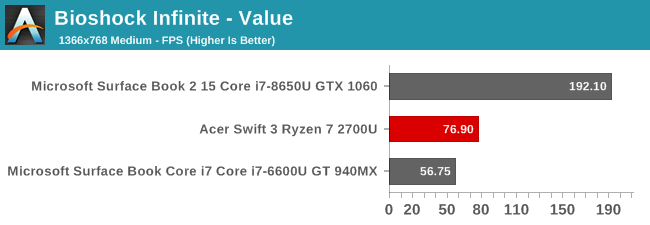
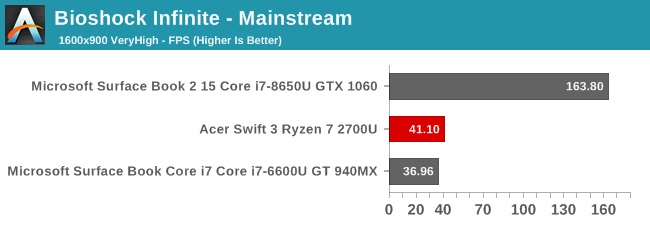
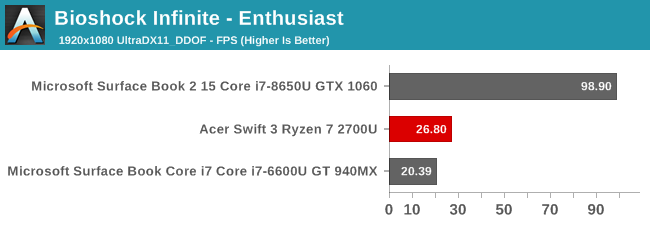
It’ll be sad to put this game to rest in our test suite since we have a tremendous amount of data for it, but it’s a good test for the kind of game you could expect to play well on a device with an integrated Vega GPU, and the Ryzen 7 performs quite well unless you max out the settings.
Shadow of Mordor

While getting close to the limits of playable, you could get by on Shadow of Mordor on lighter settings.
Grid Autosport



This game was very playable on the integrated graphics, although at maximum settings it’s kind of on the edge.
GPU Conclusion
For the longest time, we’ve been wondering if Intel’s GPU limits are due to architecture or TDP, since they’ve not really improved much over the years. Even the Iris graphics struggle. AMD has proven that theory wrong. Despite sharing just 15-Watts between the CPU and GPU, Ryzen 7 delivers respectable performance from the GPU, allowing gaming on integrated graphics with quite a bit of success. No, it can’t compete with the GTX 1060 in the Surface Book 2, but it does outperform the GT 940MX in the original Surface Book. The GPU in the Ryzen 7 2700U is just impressive.










78 Comments
View All Comments
kaidenshi - Thursday, May 3, 2018 - link
640KB is enough for anyone.In all seriousness, this is a midrange laptop and 8GB is midrange these days. Unless you're trying to use it for containers/VMs, 8GB is plenty for the kind of use case a laptop like this will see.
Now, if they included the right GPU to make it a gaming laptop, I'd love to see it come with 16GB with the option of 32GB. But in this case, 8GB is plenty.
Targon - Tuesday, May 8, 2018 - link
That is the problem, a mid-range laptop is generally that $450-$650 range. Add the SSD and you go into the next price category. RAM being overpriced at this point is a part of the problem, but it isn't the only reason the cheapest you can find a Ryzen based laptop is $600 at this point.kfishy - Wednesday, May 9, 2018 - link
Unfortunately a side effect of Ryzen’s success is retailers can mark it up much more.Jimster480 - Monday, May 28, 2018 - link
There are $400 Ryzen 3 laptops, its just that if its a Ryzen 5+ then its double the cost.Jimster480 - Monday, May 28, 2018 - link
Its not when its a single channel 2133mhz ram setup...Its the cheapest ram, cheapest SSD, cheapest screen, cheapest battery.... all for a price more than an i7 + dedicated GPU with double the ram!
tn_techie - Thursday, May 3, 2018 - link
Regarding Cinebench and system tests, it's clear that premium built notebooks like Microsoft's surface products, or even the Asus Zenbooks, will have better results than the Swift 315, as the components quality and thermal solutions are way higher than the Swift's. Most plasticky midrange notebooks with Kaby Lake R chips score lower Cinebench results than the 2700U when coupled with a random nonchalant thermal solution from the likes of Acer, Asus or any of the major OEMs. The problem with Raven Ridge, is that it can't feature on higher end designs, due to the lack of LPDDR support, and therefore it won't benefit from the advantage of being on a truly premium system, with great cooling, a big battery, full cutting edge connectivity, best-in-class NVMes etc.. It's condemned, at best, to the high midrange tier, with tradeoffs and sacrifices here and there.Spunjji - Friday, May 4, 2018 - link
I'm pretty sure it's less the LPDDR support and more mindshare / marketing dollars that keep AMD out of the high-end products.tn_techie - Friday, May 4, 2018 - link
I think that the Ryzen brand has proved itself over the last 12 months. There's a lot of excitement around it, and its reputation is actually sky high. That's why I don't think it's the old mindshare issue, with people automatically recognizing AMD based products as low-end. However, consumers associate high-end CPUs with the premium notebook offerings. And as long as you're unable to showcase your products in the XPS, Spectre, Zenbook, Surface etc.. lineups, you won't be granted the full recognition you deserve. And the lack of LPDDR support is the main hurdle here.Try putting a 2700U in the chassis of an XPS 13 for example. Battery life will be disappointing, but performance would be outstanding.
Jimster480 - Monday, May 28, 2018 - link
The battery life of the XPS13 is very disappointing... especially since the Spectre and Meltdown bugs... I can barely get 4 hours out of my XPS13 just browsing in Firefox...Its basically a useless disaster of a laptop with poor performance for anything outside of web browsing.
Intel knows it and they will pay billions to keep the ryzen chips out of something like the XPS13.
LPDDR vs DDR4 really isn't a major factor when it comes to notebook battery life. It may sacrifice an hour or two but considering the actual tested battery life of basically every intel machine post these patches for the CPU bugs.... well I think the two would be on par with the Ryzen maybe even pulling ahead.
Jimster480 - Monday, May 28, 2018 - link
Exactly! There is no disadvantage to Ryzen that keeps it out of the premium sector other than that its made by AMD and Intel is throwing marketing dollars at companies to make sure AMD doesn't see the light of day.